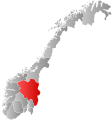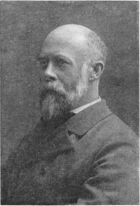Folldal
Folldal kommune | |
|---|---|
 Coat of arms  Innlandet within Norway | |
 Folldal within Innlandet | |
| Coordinates: 62°11′57″N 10°2′7″E / 62.19917°N 10.03528°ECoordinates: 62°11′57″N 10°2′7″E / 62.19917°N 10.03528°E | |
| Country | Norway |
| County | Innlandet |
| District | Østerdalen |
| Administrative centre | Folldal |
| Government | |
| • Mayor (2019) | Kristin Langtjernet[1] (Ap) |
| Area | |
| • Total | 1,275 km2 (492 sq mi) |
| • Land | 1,257 km2 (485 sq mi) |
| Area rank | 73 in Norway |
| Population (2018) | |
| • Total | 1,587 |
| • Density | 1.2/km2 (3/sq mi) |
| • Change (10 years) | −5.5% |
| Demonym(s) | Folldøl[2] |
| Time zone | UTC+01:00 (CET) |
| • Summer (DST) | UTC+02:00 (CEST) |
| ISO 3166 code | NO-3429 |
| Official language form | Neutral[3] |
| Website | www |
Folldal is a municipality in Innlandet county, Norway. It is part of the traditional region of Østerdalen. It is bordered on the north by Oppdal and Tynset municipalities, in the east by Alvdal municipality, in the south by Stor-Elvdal, Sør-Fron and Sel municipalities, and in the west by Dovre municipality. The administrative centre of the municipality is the village of Folldal. Mining at the Folldal mines was the main industry for Folldal's residents from the 18th century until the last mine related operation in 1993. The new municipality of Folldal was separated from Alvdal in 1914.
General information[]

Name[]
The first element is the river name Folla and the last element is dal which means "valley" or "dale". The meaning of the river name is unknown (perhaps "the broad one").
Coat-of-arms[]
The coat-of-arms is from modern times. They were granted in 1988. The arms show a gold-colored pickaxe on a red background. This was chosen to represent mining and agriculture in the municipality.
History[]

Mining has been important to Folldal's development from the 18th century to the present. The Folldal works (Folldal Verk) was founded in 1748. Folldal's main copper mine, Gammelgruva, also opened in 1748. The mine employed up to 550 people. Until the 1878 ore was transported by horse-drawn vehicles to the Lovise smelter located in neighboring Alvdal municipality. From 1878 to 1906 there was a lull in operations. Operations were restarted in 1906 with ore was transported by a 34 km long cable car (Northern Europe's longest) to the smelter. The main mine played out and was closed in 1941. Smelting continues using ore from several other deposits in the area until 1968. Then the mining and ore dressing moved to Tverrfjellet at Hjerkinn, in Dovre municipality, approximately 30 km from Folldal. The business was closed in 1993.
Church[]
The church in Folldal was a satellite church of that in Lesja, as was the church at the iron ore mines at Lesjaverk (Lesja Iron Works). Per Berg reports,
“When the sexton Ola Kring died in Lesja in 1751, Frederik Wiborg was appointed sexton there and was presented to the congregation on the third Sunday following Trinity. There certainly wasn't anything very special about being a teacher in Ringsaker, if he was willing to change that for being a sexton. No house or land went with the post and the work was hard. In the Lesja parish there were three satellite churches - Lesjeverk, Dovre, and Folldal. The travel distances were great and it could be very difficult in the winter.”[4]
Geography[]

Folldal is located along the northwestern border of Hedmark county. It is bordered in the north by Oppdal (in Sør-Trøndelag county) and Tynset, in the east by Alvdal, in the southeast by Stor-Elvdal, and to the southwest and west by Sør-Fron, Sel, and Dovre (all in Oppland county). Folldal Municipality has the country's highest administrative center (712.5 meters above sea level) and has picturesque scenery with mountains and valleys. The village lies at the foot of Rondeslottet mountain and Snøhetta mountain. The area also has many interesting geologic features from the last Ice Age. Norway's longest seter valley, the 55 kilometer long Einunndalen, lies within the municipality. The Einunndalen is still actively used for summer grazing at the seters (mountain summer farms) established in the 1700s. Almost half of the municipal land is protected as conservation areas and national parks, including parts that are included in the Rondane National Park and Dovrefjell–Sunndalsfjella National Park.
A national tourist road, the RV 27, runs through the municipality.
Climate[]
Folldal has a subarctic climate (Dfc) with short, cool summers and long, cold winters. Situated in a mountain valley on the southern, continental side of the Dovre mountain range at 694 m ASL, it has the coldest winters in the southern half of Norway
| Climate data for Folldal Mean average temperatures and precipitation (694 m). | |||||||||||||
|---|---|---|---|---|---|---|---|---|---|---|---|---|---|
| Month | Jan | Feb | Mar | Apr | May | Jun | Jul | Aug | Sep | Oct | Nov | Dec | Year |
| Daily mean °C (°F) | −10.6 (12.9) |
−8.9 (16.0) |
−4.7 (23.5) |
0.7 (33.3) |
5.6 (42.1) |
9.7 (49.5) |
12.3 (54.1) |
10.8 (51.4) |
6.6 (43.9) |
0.4 (32.7) |
−6.2 (20.8) |
−9.5 (14.9) |
0.5 (32.9) |
| Average precipitation mm (inches) | 21.9 (0.86) |
16.1 (0.63) |
15.4 (0.61) |
13.7 (0.54) |
33.9 (1.33) |
54.1 (2.13) |
69.4 (2.73) |
78.6 (3.09) |
27 (1.1) |
28.6 (1.13) |
24.2 (0.95) |
20.4 (0.80) |
403.3 (15.9) |
| Source: [1] | |||||||||||||
Outdoors[]
Folldal offers a wide variety of outdoor activities. Hiking is good with marked trails and several cabins to visit. Fishing can be done in the rivers Folla, Einunna or Glomma. The opportunities for hunting in the area are also good.
Notable people[]

- Ivar Mortensson-Egnund (1857–1934) a Norwegian author, journalist, theologian, researcher, translator, writer, philosopher and advocate of nynorsk, lived at Einabu in Folldal from 1894
- Olav Dalgard (1898 in Folldal – 1980) a literary and art historian, filmmaker, author and educator [5]
- Tore Segelcke (1901–1979) an actress, from 1959 she spent many summers in Folldal [6]
- Olav Odden (1914 in Folldal – 1969) a Norwegian skier, competed in cross-country skiing and Nordic combined at the 1948 Winter Olympics
- Erling Brandsnes (born 1945 in Folldal) a Norwegian politician Mayor of Folldal 1987-1999
- Hans Einar Krokan (born 1945 in Folldal) a Norwegian physician and cancer researcher
- Svein Borkhus (born 1955 in Dalholen) a Norwegian politician, Mayor of Folldal 1999-2007 and from 2011
References[]
- ^ "(+) Loddtrekning om siste plass i formannskapet i Folldal. Her holder gammelordfører Hilde svaret i handa". www.ostlendingen.no (in Norwegian). 2019-10-03. Retrieved 2019-10-06.
- ^ "Navn på steder og personer: Innbyggjarnamn" (in Norwegian). Språkrådet.
- ^ "Forskrift om målvedtak i kommunar og fylkeskommunar" (in Norwegian). Lovdata.no.
- ^ Berg, Per. Ei Wiborg-ættegrein på Lesja 1751–1900 (in Norwegian).
- ^ IMDb Database retrieved 06 October 2020
- ^ IMDb Database retrieved 06 October 2020
External links[]
 Media related to Folldal at Wikimedia Commons
Media related to Folldal at Wikimedia Commons The dictionary definition of Folldal at Wiktionary
The dictionary definition of Folldal at Wiktionary- Municipal fact sheet from Statistics Norway
- Folldal Verk
- Folldalsportalen (in Norwegian)
- National touristroute[permanent dead link]
- Folldal
- Municipalities of Hedmark
- Villages in Hedmark
- Villages in Innlandet



